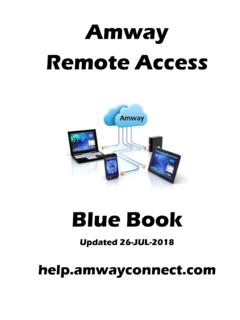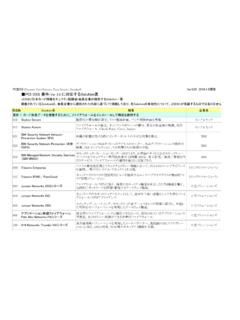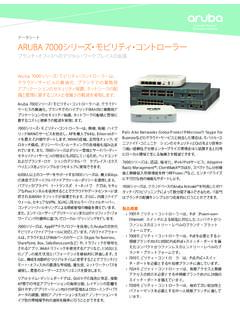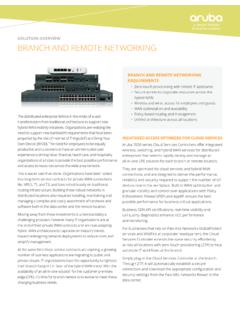Transcription of TACACS+ Advantages comp - TACACS.net | Free …
1 The Advantages of tacacs + forAdministrator AuthenticationCentrally manage and secure your network devices with one easy to deploy departments are responsible for managing many routers, switches, firewalls, and access points throughout a network. They need to be able to implement policies to determine who can log in to manage each device, what operations they can run, and log all actions taken. Managing these policies separately on each device can become unmanageable and lead to security incidents or errors that result in loss of service and network downtime.
2 Most compliance requirements and security standards require using standardized tools to centralize authentication for administrative management. Some vendors offer proprietary management systems, but those only work on that vendor's devices, and can be very expensive. Many IT departments choose to use AAA (Authentication, Authorization and Accounting) protocols RADIUS or tacacs + to address these issues. These protocols enable you to have all network devices managed by a single platform, and the protocols are already built in to most more information, visit | 2011 DifferencesRADIUS was designed to authenticate and log dial-up remote users to a network, and tacacs + is used most commonly for administrator access to network devices like routers and switches.
3 This is indicated in the names of the protocols. RADIUS stands for Remote Access Dial-In User Service, and tacacs + stands for Terminal Access Controller Access Control Service primary functional difference between RADIUS and tacacs + is that tacacs + separates out the Authorization functionality, where RADIUS combines both Authentication and Authorization. Though this may seem like a small detail, it makes a world of difference when implementing administrator AAA in a network environment.
4 RADIUS doesn t log the commands used by the administrator. It will only log the start, stop, and interim records of that session. This means that if there are two or more administrators logged at any one time, there is no way of telling which administrator entered which commands. RADIUS can include privilege information in the authentication reply; however, it can only provide the privilege level, which means different things to different vendors.
5 Because there is no standard between vendor implementations of RADIUS authorization, each vendor s attributes often conflict, resulting in inconsistent results. Even if this information were consistent, the administrator would still need to manage the privilege level for commands on each device. This will quickly become doesn t log the commands used by the administrator. It will only log the start, stop, and interim records of that session. This means that if there are two or more administrators logged at any one time, there is no way to tell from the RADIUS logs which administrator entered which commands.
6 2 RADIUS was designed for subscriber AAA, and tacacs + is designed for administrator AAA. RADIUS can still be used for small network administrator AAA, but only if authorization is not required, or if it is a homogeneous network (all one vendor). In any scenario where there is a heterogeneous environment or authorization policies are required for network devices, tacacs + is the best was designed for subscriber AAA, and tacacs + was designed for administrator 1: RADIUS vs.
7 TACACS+ RADIUSTACACS+AUTHENTICATION REPLYAUTHENTICATION REQUESTAUTHORIZATION LEVELACCOUNTINGNASUSERRADIUSNASUSERTACAC S+AUTHENTICATION REQUESTAUTHENTICATION REPLYAUTHORIZATION LEVELAUTHORIZATION REQUESTAUTHORIZATION REPLYACCOUNTINGTACACS+ AdvantagesFor more information, visit | 2011 tacacs + protocol was developed to resolve these issues. tacacs + is a standard protocol developed by the Department of Defense, and later enhanced by Cisco Systems. tacacs + separates out the authorization functionality, so it enables additional flexibility and granular access controls on who can run which commands on specified devices.
8 Each command entered by a user is sent back to the central tacacs + server for authorization, which then checks the command against an authorized list of commands for each user or group. tacacs + can define policies based on user, device type, location, or time of day. The tacacs + service can use locally configured users or users and groups defined in Active Directory or LDAP to control access to devices in your network. This enables Single Sign-On (SSO), which increases security, simplifies management, and makes it easier for users.
9 3 Table 1: RADIUS vs. TACACS+ RADIUSTACACS+Combines authentication & all 3 elements of AAA, making it more secure only runs a hash on the secure - Encrypts the whole packet including username, password, and each network device to contain authorization management for authorization command command vendor support for by most major ConnectionlessUDP ports 1645/1646, 1812/1813 TCP- Connection orientedTCP port 49 Designed for subscriber AAAD esigned for administrator AAAV endor SupportMost Enterprise or Carrier-class network device manufacturers support tacacs + including Adtran, Alcatel/Lucent, Arbor, Aruba, Avocent/Cyclades, Blade Networks, BlueCat Networks, Blue Coat, Brocade/Foundry, Cisco/Linksys, Citrix, Dell, Edgewater, EMC, Enterasys, Ericsson/Redback, Extreme, Fortinet, Fujitsu, HP/3 Com, Huawei, IBM.
10 Juniper/Netscreen, Netgear, Nortel, Palo Alto Networks, Radware, Riverstone, Samsung, and many + AdvantagesFor more information, visit | 2011 ConsiderationsIt is generally not a good idea to deploy RADIUS and tacacs + services on the same server. There may be a perceived advantage to consolidating these services because they are both AAA protocols, however, they are deployed for different purposes, they use resources differently, and the licensing can be unnecessarily expensive.







